Branding: Coordinating My Wardrobe to the HARP Colour Palette
Posted by Dorothy Lander: dorothy@tryhealingarts.ca The talented team at This is Marketing (https://www.thisismarketing.ca/) chose a unique colour palette to illuminate
Unlock your Cuddle Hormone in 2022
Oxytocin is our brain’s chemical messenger that has come to be known as the cuddle hormone. Oxytocin first entered our consciousness while we were compiling a list of simple recommendations to lighten our carbon footprint for our HARP blog loosely titled Go Lightly on Our Earth. (https://stagingnest.tech/go-lightly-on-our-earth/)
Specifically, we were advocating for mothers to breastfeed rather than use infant formula, after discovering that—added to all its other wonderful benefits—breastfeeding was good for our environment. And so we came to rename our HARP blog Travels with a Low-Carbon, High-Cuddle Couple.
Oxytocin, the hormone that causes the uterus to contract during labour and after delivery, is transferred from a mother’s blood to her milk as soon as she starts to breast feed. Oxytocin released during this skin-to-skin contact enables newborns and mothers to learn each other’s special scent. It has come to be known as the cuddle hormone, or love hormone, because it is released when people—not just mothers and babies—snuggle up, make love, or simply bond socially. Oxytocin is produced by the hypothalamus and released by the pituitary gland when we’re physically affectionate, producing feelings of connection, bonding, and trust.
As healing arts practitioners in a pandemic that places widespread restrictions on expressions of physical affection, we began to wonder whether, and how, we humans can release oxytocin when we are virtually affectionate. Since 2007 the World Health Organization has been recommending the use of mothers’ milk over formula because of its proven positive effects on babies’ short-term and long-term physical health. There is more recent evidence that oxytocin is necessary for babies’ social development, but this is not what first grabbed our attention as climate activists. Rather, we were calling for support for breastfeeding because use of infant and toddler formulas exacerbates environmental damage.
“Human milk is not skimmed, processed, pasteurized, homogenized, packaged, stored, transported, repackaged, dried, reconstituted, sterilized or wasted. More important to many people nowadays, it is not genetically modified (GM). It requires no fuel for heating, no refrigeration, and is always ready to serve at the right temperature. In short, it is the most environmentally friendly food available.” (Francis and Mulford 2000)
https://www.gifa.org/wp-content/uploads/2015/01/FormulaForDisaster.pdf
But oxytocin’s vital part in reducing our carbon footprints in every sphere of life has yet to warrant a mention in global commitments to breastfeeding. Oxytocin does not appear in a study by Dr. Natalie Shenker’s team at Imperial College London that shows that breastfeeding for six months saves an estimated 95-153 kg CO2 equivalents per baby compared with formula feeding. In the UK alone, carbon emission savings gained by every mother breastfeeding would equate to taking between 50,000 and 77,500 cars off the road each year.
https://www.imperial.ac.uk/news/193226/environmental-cost-formula-milk-needs-global/
All research begins with a hunch—and in our case with a cuddle since we often wake up with Aha! moments. We had this hunch that the cuddles we first experienced at our mother’s breast could still hold us in good stead when we come to address issues that are now preoccupying many of us as adults—our global climate emergency. In 2019 in Toronto, we participated in the Climate Tour with Buffy Sainte-Marie, Stephen Lewis and David Suzuki—a veritable climate activists’ rock concert. The audience rose as one when Buffy pronounced that “we’re all in this together” and invited us to sing along with her 1971 hit song “Carry it On.”
But we didn’t immediately connect Buffy Sainte-Marie’s climate activism to her groundbreaking decision in 1977 to breastfeed her baby Cody on Sesame Street. Her action at once normalized nursing a baby as natural and healthy for millions of parents and their children who religiously tuned into Sesame Street on their TVs.
Big Bird: “What’cha doing, Buffy?”
Buffy: “I’m feeding the baby. See? He’s drinking milk from my breast.”
Big Bird: “Hmmm. That’s a funny way to feed a baby.”
Buffy: “Well, lots of mothers feed their babies this way.… and he likes it because it’s nice and warm and sweet and natural and it’s good for him.… And I get to hug him when I do it too.”
Big Bird: “You know, that’s nice.”
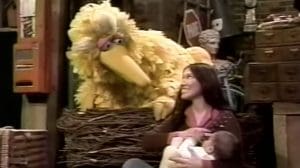
https://www.youtube.com/watch?v=l2RwZW2j3-U
Buffy wasn’t just normalizing breastfeeding; she was also normalizing the cuddle as a natural accompaniment to nursing a baby. When we watched it on YouTube, we got to wondering how that cuddle itself elevates oxytocin levels in the mother. And how might the love hormone translate more widely into strengthening social bonds and united action?
Breastfeeding, hugging, and dancing do not need normalizing in Rwanda; here breastfeeding is close to a universal practice. As healing arts practitioners in Rwanda in May 2011, we experienced directly the health benefits of cuddling and touching our human and more-than-human companions. We joined the team from University of Florida Center for Arts in Medicine to work with the Batwa dancers of Rugerero on Lake Kivu in Western Rwanda to help develop their professional dance troupe Itorero Amahoro (Peace Troupe). We soon found that massaging the dancers—a breastfeeding mother among them—prepared them magnificently for their premiere professional performance in Kigali. And we were surely releasing our own oxytocin through this intimate bonding!


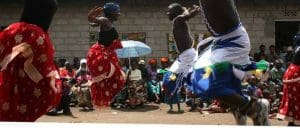

But does oxytocin galvanize collective environmental action? We waded through the research on its health benefits, including the mounting evidence of the benefits of owning and cuddling a dog or a cat. Takefumi Kikusui, an animal behaviorist at Azabu University in Japan, studied 30 people and their pets, watching for mutual gazing—that wondrous feeling you get from just looking into your dog’s or cat’s eyes—and demonstrated that it had a profound effect on their oxytocin levels. Both male and female dog owners experienced a 300 percent increase in the hormone, and both the male and female dogs experienced a 130 percent rise.
https://www.dignityhealth.org/articles/pets-and-heart-health
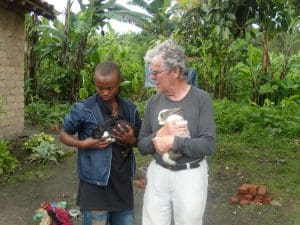

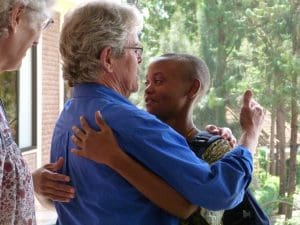

Rwanda, 2011: John and Ibrahim cuddling bunnies and each other
Many studies link survival rates after a heart attack to cat ownership. If petting your cat is so good for both your cardiovascular health and your mental health, what about daily cuddling with fellow humans?
The colour green lowers systolic blood pressure and calms the central nervous system, so you tend to feel more relaxed. So in these days of keeping your six-feet distance from other humans, how about hugging trees? The health benefits of tree-hugging related to oxytocin warrant even more attention than human cuddling. The evidence is in that tree-hugging increases your blood oxytocin levels, helping you to feel calm and to enhance your emotional bonding. Not only that, but it also triggers the hormones serotonin and dopamine, which have a direct effect on how happy you feel. And it can only help to strengthen our bonds with Nature.
https://stufftodoathome.com/try-tree-hugging-its-good-for-you/
This had us asking what role all the affectionate manifestations of human touch—hand holding, the handshake, , the hug, the kiss—play in developing our social responsibility to address the global climate emergency. Have the cuddle restrictions that Covid has imposed on us—only cuddle in your bubble—impeded the momentum for collective action?
Big Pharma has now developed synthetic oxytocin, which feels like yet another capitalist plot to replace our free cuddles with a brand-name pill—and get us to pay for it. The synthetic hormone Pitocin has been criticized for its widespread use to speed up labour.
https://abcnews.go.com/Health/study-pitocin-harm-babies/story?id=19148043
The only reference we’ve found that links oxytocin to collective action in addressing the climate crisis is in the human engineering literature https://www.smatthewliao.com/wp-content/uploads/2012/02/HEandClimateChange.htm
The authors gave synthetic oxytocin to test subjects and found that they were more willing to share money with strangers and to behave in a more trustworthy way. They conclude that altruism and empathy have biological underpinnings, which could possibly be modified by human engineering. The gist is that if we could get people to unite in expressing empathy with other life forms—indeed with Nature itself—we could increase the chances of tackling environmental problems together.
All this is prelude to our red alert that formula oxytocin presents some of the same constituents of environmental devastation as infant formula. It is a slippery slope to human species extinction if it becomes normalized to rely on a synthetic pill or an injection to feel good, to bond with others, to express fellow love—in short, to be human.
Our 2022 Commitment: Ideas and Examples
Our new year’s commitment as a low-carbon, high-cuddle couple is to counter the Covid barriers to human touch by modelling alternate and natural ways of releasing oxytocin. We offer some ideas and examples from our lived experience.
IDEAS
EXAMPLES
John wrote in his new memoir, Healing by Intent, about the origins of his “Hugs Heal” T-shirt.
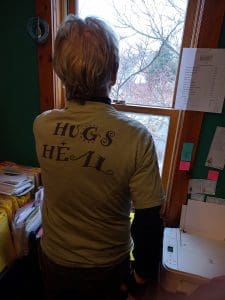

I used to speculate how often other medical colleagues encountered these kinds of feelings—what Louise Erdrich calls in her novel, Love Medicine, “the touch.” Then I attended the annual conference of the American Holistic Medical Association. I was greeted at the door by a group of half-a-dozen doctors wearing multi-coloured tee shirts with the logo Hugs Heal on the back. Our days began with yoga and tai chi, healthy breakfasts, and invigorating walks: a conscious journey of self-healing. How come it had taken me most of my working life to discover these colleagues—to discover that I wasn’t alone?
The hug features in our epistolary arts research entitled “Love Letters to the Dead.” Here are two excerpts from the letter Dorothy wrote to her deceased husband Patrick Napier.
One of our more memorable trips to London was when we heard Diana Krall at the fairly small jazz room in Pizza on the Park, when she had but one CD to her name. You had that CD, which you got hold of after hearing her sing — and yes, accompany herself on piano — in a CBC interview with Peter Gzowski. He predicted we would be hearing much more from her and so did you. In the club, you approached Diana during the break and told her how you had been following her career since first you heard her on radio. She was glad to meet a Canadian in London and introduced you to her mother who was in the audience. In the encore, Diana asked for requests, and you called out “Squeeze Me” — and then hastily clarified, “I mean the song” — but someone else had got in ahead with another request. At the end of the evening, as Diana was leaving, she came over to you and gave you a big hug. Did I enjoy teasing you that Diana knew all along that you weren’t requesting the song at all!!
And our reflective dialogue on my letter to Patrick:
Dorothy: When the surgeon (Dr. Mo) saw him last—he was moving to Virginia—he gave Patrick a huge hug, and more startling for me, Patrick returned it warmly.
John: Gosh, can you remember how that felt to see two older men from different cultures joined so intimately?
Dorothy: I was very moved. But this was a code I knew—no slant. Unconditional love between two humans, not doctor-to-patient.
John: The surgeon’s hug seems like an act of real nobility. Isn’t it a wonderful juxtaposition for those brown Semitic hands that had skillfully removed 180 centimetres of Patrick’s colon to now embrace him. That’s Octavio Paz’s true art of handicraft.
Dorothy: Oh, lovely, use and beauty, no either-or.
How about this image entitled The Hug, which Nova Scotia artist Robert Pope created while he was in remission from the cancer, which ultimately took his life? A reproduction of this picture is on the wall of the Progressive Care Unit in St. Martha’s Hospital in Antigonish, where Patrick died in 2004 – a reminder that we can release oxytocin at every stage of our life.
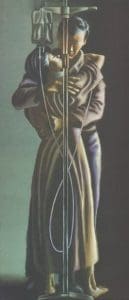

Posted by Dorothy Lander: dorothy@tryhealingarts.ca The talented team at This is Marketing (https://www.thisismarketing.ca/) chose a unique colour palette to illuminate
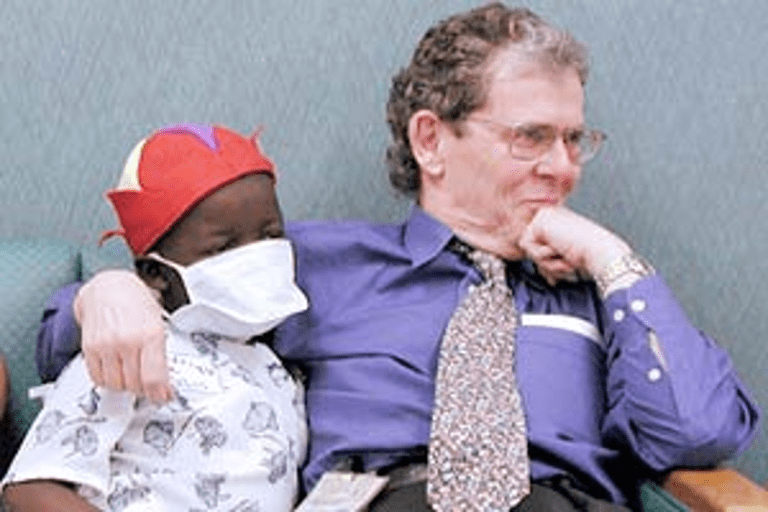

L to R Clockwise: John Graham-Pole aged 2 on Mummy’s knee with sisters Elizabeth, Mary, and Jane, High Bickington, Devon,
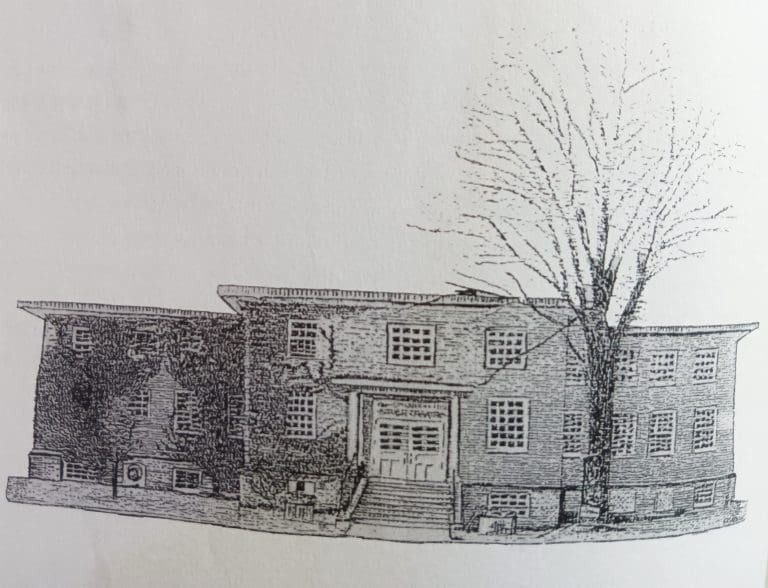

Posted by Dorothy Lander Once a month, John Graham-Pole and I showcase the publications of HARP The People’s Press at
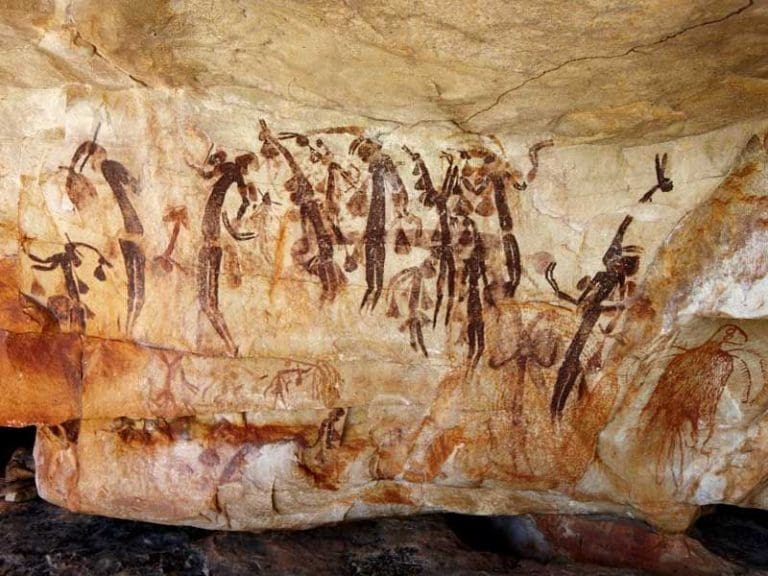

Aboriginal Rock Mural Kimberley Region, Western Australia Posted by John Graham-Pole I don’t have answers to any of these questions,
| Cookie | Duration | Description |
|---|---|---|
| cookielawinfo-checkbox-analytics | 11 months | This cookie is set by GDPR Cookie Consent plugin. The cookie is used to store the user consent for the cookies in the category "Analytics". |
| cookielawinfo-checkbox-functional | 11 months | The cookie is set by GDPR cookie consent to record the user consent for the cookies in the category "Functional". |
| cookielawinfo-checkbox-necessary | 11 months | This cookie is set by GDPR Cookie Consent plugin. The cookies is used to store the user consent for the cookies in the category "Necessary". |
| cookielawinfo-checkbox-others | 11 months | This cookie is set by GDPR Cookie Consent plugin. The cookie is used to store the user consent for the cookies in the category "Other. |
| cookielawinfo-checkbox-performance | 11 months | This cookie is set by GDPR Cookie Consent plugin. The cookie is used to store the user consent for the cookies in the category "Performance". |
| viewed_cookie_policy | 11 months | The cookie is set by the GDPR Cookie Consent plugin and is used to store whether or not user has consented to the use of cookies. It does not store any personal data. |